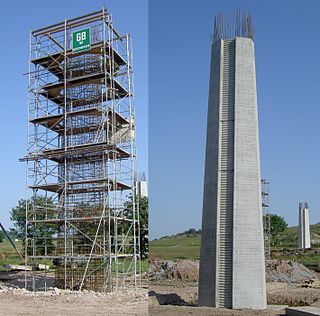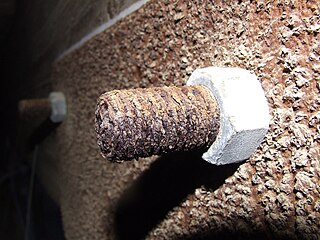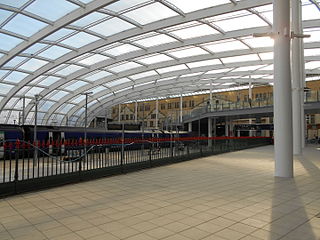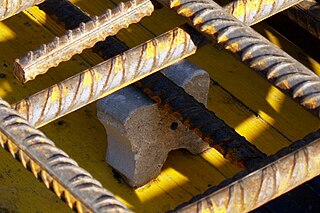Methods of maintaining cover gallery
- Plastic strip bar chairs supporting heavy rebar on suspended slab.
- Tiny distance holders (chairs) of concrete.
- Plastic underlayers.
- Effects of too little cover – poor concrete.
Concrete cover, in reinforced concrete, is the least distance between the surface of embedded reinforcement and the outer surface of the concrete (ACI 130). The concrete cover depth can be measured with a cover meter. The purpose of concrete cover is to protect the reinforcement from corrosion, fire, and other potential damage.
The required concrete cover depends on several factors, including the environmental conditions to which the structure will be exposed, the size of the reinforcing steel, the concrete strength, and the type of structure being constructed. Generally, larger diameter reinforcement bars require more concrete cover than smaller ones.
In most cases, local building codes and engineering standards specify the minimum required concrete cover for various types of structures. It is important to adhere to these requirements to ensure the safety and longevity of the structure.
The concrete cover must have a minimum thickness for three main reasons:
The premature failure of corroded steel reinforcements and the expansion of the iron corrosion products around the rebars are amongst the main causes of the concrete degradation. The carbon steel of rebars is protected from oxidation by atmospheric oxygen by the high pH of concrete interstitial water. Iron bar surface is passivated as long as the pH value is higher than 10.5. Fresh cement water has a pH of about 13.5 while evolved cement water pH ~ 12.5 is controlled by the dissolution of calcium hydroxide (portlandite). Carbon dioxide present in the air slowly diffuses through the concrete cover over the rebar and progressively reacts with the alkaline hydroxides (KOH, NaOH) and with calcium hydroxide leading to the carbonatation of the hydrated cement paste. As a result, the pH of the cement drops and when its value is below 10.5 – 9.5, steel surface is no longer passivated and starts to corrode. A sufficient thickness of concrete cover is thus required in order to slow down the carbonatation process towards the rebar. The minimum concrete cover will depend on the environmental conditions encountered and must be thicker when the concrete is also exposed to moisture and chloride (proximity to the sea, use of de-icing salt for bridges or roads, ...). A high quality concrete made with a low water-to-cement (w/c) ratio will have a lower porosity and will be less permeable to water and to the ingress of corrosive species (dissolved oxygen, chloride, ...). A thicker cover or a more compact concrete will also reduce the diffusion of CO2 in the concrete, protecting it better from carbonatation and maintaining a higher pH for a longer time period, increasing so the rebar service life.
Concrete covers are frequently used in the construction of commercial developments, homes, bridges, municipalities, curb forming, and other locations or projects requiring long-lasting, durability. [2] Concrete and steel reinforcement bars combine to create strong, resilient structures in the following ways:
National codes also specify minimum cover requirements based on their respective local exposure conditions.
| Country | Concrete Code | Range of Concrete Cover (mm) |
|---|---|---|
| UK | BS:8110 | 25-50 |
| EU | EN 1992 (EC2) | diameter +10 - 55 |
| USA | ACI:318 | 40-75 |
| Australia | AS:3600 | 15-78 |
| India | IS 456 (2000) | 20-75 |
Large cover depths (50–75 mm) are required to protect reinforcement against corrosion in aggressive environments, but thick cover leads to increased crack widths in flexural reinforced concrete members. Large crack-widths (greater than 0.3 mm) permit ingress of moisture and chemical attack to the concrete, resulting in possible corrosion of reinforcement and deterioration of concrete. Therefore, thick covers defeat the very purpose for which it is provided. There is a need for judicious balance of cover depth and crack width requirements.
A possible economical solution for this paradox is the placing of a second layer of corrosion-resistant reinforcement like stainless steel rebars or meshes or FRP rebars in the concrete cover to distribute the cracks.

Concrete is a composite material composed of aggregate bonded together with a fluid cement that cures over time. Concrete is the second-most-used substance in the world after water, and is the most widely used building material. Its usage worldwide, ton for ton, is twice that of steel, wood, plastics, and aluminium combined.

Rust is an iron oxide, a usually reddish-brown oxide formed by the reaction of iron and oxygen in the catalytic presence of water or air moisture. Rust consists of hydrous iron(III) oxides (Fe2O3·nH2O) and iron(III) oxide-hydroxide (FeO(OH), Fe(OH)3), and is typically associated with the corrosion of refined iron.

Reinforced concrete, also called ferroconcrete, is a composite material in which concrete's relatively low tensile strength and ductility are compensated for by the inclusion of reinforcement having higher tensile strength or ductility. The reinforcement is usually, though not necessarily, steel bars (rebar) and is usually embedded passively in the concrete before the concrete sets. However, post-tensioning is also employed as a technique to reinforce the concrete. In terms of volume used annually, it is one of the most common engineering materials. In corrosion engineering terms, when designed correctly, the alkalinity of the concrete protects the steel rebar from corrosion.

Corrosion is a natural process that converts a refined metal into a more chemically stable oxide. It is the gradual deterioration of materials by chemical or electrochemical reaction with their environment. Corrosion engineering is the field dedicated to controlling and preventing corrosion.

Rebar, known when massed as reinforcing steel or reinforcement steel, is a steel bar used as a tension device in reinforced concrete and reinforced masonry structures to strengthen and aid the concrete under tension. Concrete is strong under compression, but has low tensile strength. Rebar significantly increases the tensile strength of the structure. Rebar's surface features a continuous series of ribs, lugs or indentations to promote a better bond with the concrete and reduce the risk of slippage.
Carbonatation is a chemical reaction in which calcium hydroxide reacts with carbon dioxide and forms insoluble calcium carbonate:

Pitting corrosion, or pitting, is a form of extremely localized corrosion that leads to the random creation of small holes in metal. The driving power for pitting corrosion is the depassivation of a small area, which becomes anodic while an unknown but potentially vast area becomes cathodic, leading to very localized galvanic corrosion. The corrosion penetrates the mass of the metal, with a limited diffusion of ions.

A concrete slab is a common structural element of modern buildings, consisting of a flat, horizontal surface made of cast concrete. Steel-reinforced slabs, typically between 100 and 500 mm thick, are most often used to construct floors and ceilings, while thinner mud slabs may be used for exterior paving .

Structural steel is a category of steel used for making construction materials in a variety of shapes. Many structural steel shapes take the form of an elongated beam having a profile of a specific cross section. Structural steel shapes, sizes, chemical composition, mechanical properties such as strengths, storage practices, etc., are regulated by standards in most industrialized countries.
The water–cement ratio is the ratio of the mass of water to the mass of cement used in a concrete mix:
Fiber-reinforced concrete or fibre-reinforced concrete (FRC) is concrete containing fibrous material which increases its structural integrity. It contains short discrete fibers that are uniformly distributed and randomly oriented. Fibers include steel fibers, glass fibers, synthetic fibers and natural fibers – each of which lend varying properties to the concrete. In addition, the character of fiber-reinforced concrete changes with varying concretes, fiber materials, geometries, distribution, orientation, and densities.

A rebar spacer is a device that secures the reinforcing steel or "rebar" in reinforced concrete structures as the rebar is assembled in place before the final concrete pour. The spacers are left in place during the pouring to keep the rebars in place. After the pour, the spacers become a part of the structure.
A cement accelerator is an admixture for the use in concrete, mortar, rendering or screeds. The addition of an accelerator speeds the setting time and thus cure time starts earlier. This allows concrete to be placed in winter with reduced risk of frost damage. Concrete is damaged if it does not reach a strength of 500 pounds per square inch (3.4 MPa) before freezing.

Structural engineering depends on the knowledge of materials and their properties, in order to understand how different materials resist and support loads.

Textile-reinforced concrete is a type of reinforced concrete in which the usual steel reinforcing bars are replaced by textile materials. Instead of using a metal cage inside the concrete, this technique uses a fabric cage inside the same.

Concrete degradation may have many different causes. Concrete is mostly damaged by the corrosion of reinforcement bars due to the carbonatation of hardened cement paste or chloride attack under wet conditions. Chemical damages are caused by the formation of expansive products produced by various chemical reactions, by aggressive chemical species present in groundwater and seawater, or by microorganisms. Other damaging processes can also involve calcium leaching by water infiltration and different physical phenomena initiating cracks formation and propagation. All these detrimental processes and damaging agents adversely affects the concrete mechanical strength and its durability.
Concrete has relatively high compressive strength, but significantly lower tensile strength. The compressive strength is typically controlled with the ratio of water to cement when forming the concrete, and tensile strength is increased by additives, typically steel, to create reinforced concrete. In other words we can say concrete is made up of sand, ballast, cement and water.
Sulfur concrete, sometimes named thioconcrete or sulfurcrete, is a composite construction material, composed mainly of sulfur and aggregate. Cement and water, important compounds in normal concrete, are not part of sulfur concrete. The concrete is heated above the melting point of elemental sulfur at ca. 140 °C (284 °F) in a ratio of between 12% and 25% sulfur, the rest being aggregate.
Calcium nitrite is an inorganic compound with the chemical formula Ca(NO
2)
2. In this compound, as in all nitrites, nitrogen is in a +3 oxidation state. It has many applications such as antifreeze, rust inhibitor of steel and wash heavy oil.
The durability design of reinforced concrete structures has been recently introduced in national and international regulations. It is required that structures are designed to preserve their characteristics during the service life, avoiding premature failure and the need of extraordinary maintenance and restoration works. Considerable efforts have therefore made in the last decades in order to define useful models describing the degradation processes affecting reinforced concrete structures, to be used during the design stage in order to assess the material characteristics and the structural layout of the structure.